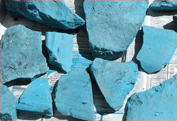
Last month we were given permission, at short notice, to excavate on land behind gardens in Higher Ince. This area is where the council are carrying out remediation work to remove contaminated soil (as reported in Newsletter 101). Brain Parr has been monitoring the situation and, spying an opportunity, put forward a submission to the council. On the Saturday (9th) Brian, Mark and I went down with a digger to put in a number of test pits where we suspected the Roman Road crossed the housing estate. The site is on the east side of Ince Green Lane opposite St William's School with the entrance down the side of No.11 Leaway. When we got there the council had already removed the regulation 60cm of topsoil required for the remediation work. Before the housing estate was built very little building activity is shown on the early maps in this area east of Ince Green Lane. Also coring by the contractors had shown a good depth of infill on top of the natural ground surface (in some places as deep as 8 metres).
| |

Using our digger Mark cut a series of trenches down to a depth of 2 metres (on average) cutting through the various levels until reaching the natural sub-strata. The results, however, were not very encouraging; there was no sign of the Roman Road in any of the trenches we dug. What we did find, however, was a deep layer of Victorian ash and cinder to a depth of 1.5 metres. Under this was a thick black layer of organic material which must represent the original ground level. This lay on top of layers of the soft sedimentary clays representing the natural sub-soil. This is a disappointing result as we were hoping to confirm the projection of the strong line shown on the 1849 OS map at Amberswood Common. The result also puts into doubt the resistivity survey we did on the other side of the road behind St Williams' School (see Newsletter 102). One conclusion is that the road may have deviated further to the north, maybe on an alignment with George Street (Brian has still got an option with the council for work in that area). It has been decided, however, that we will still pursue the excavation at St William's so that we can confirm or otherwise the findings from Leaway.
| Excavation Programme
 This latest site brings the total number of sites we have been, or are currently investigating in Higher Ince to 6. The others include St William's School (as just mentioned), 2 sites in Walmsley Park (the Big Dig site and the recent embankment site) and 2 sites on either site of the land fill on the Ince / Hindley border. Last month Tom put in for a grant from the Awards For All Scheme which will be used specifically to progress the St William's site, but will also stand us in good stead for further funding for the others site too. It is also our intention, in the long term, to revisit some of the sites further east along this Roman Road to Manchester - such as Smallbrook in Hindley Green (where we suspect there was a ford - Newsletter 57) and Cleworth Hall in Tyldesley (see Newsletters 71 & 72). This latest site brings the total number of sites we have been, or are currently investigating in Higher Ince to 6. The others include St William's School (as just mentioned), 2 sites in Walmsley Park (the Big Dig site and the recent embankment site) and 2 sites on either site of the land fill on the Ince / Hindley border. Last month Tom put in for a grant from the Awards For All Scheme which will be used specifically to progress the St William's site, but will also stand us in good stead for further funding for the others site too. It is also our intention, in the long term, to revisit some of the sites further east along this Roman Road to Manchester - such as Smallbrook in Hindley Green (where we suspect there was a ford - Newsletter 57) and Cleworth Hall in Tyldesley (see Newsletters 71 & 72).
Next Meeting
Wednesday 3rd October at the District Scout HQ (Baden Powell Centre) in Greenough Street, starting at 7.30 pm as usual. This month we have, at short notice, Dot Waring from Darwen Historical Society who will be talking about her experiences as a volunteer at the Dilston Castle Summer School (including the mysterious tale of some documents she received from Germany 20 years ago). The Summer School is run by North Pennine Archaeological Trust and the site they are currently working on has turned up some fascinating results. Dot's presentations are always highly entertaining and I'm sure this will be no exception.
Hope to see you there
B.A.
|
|



